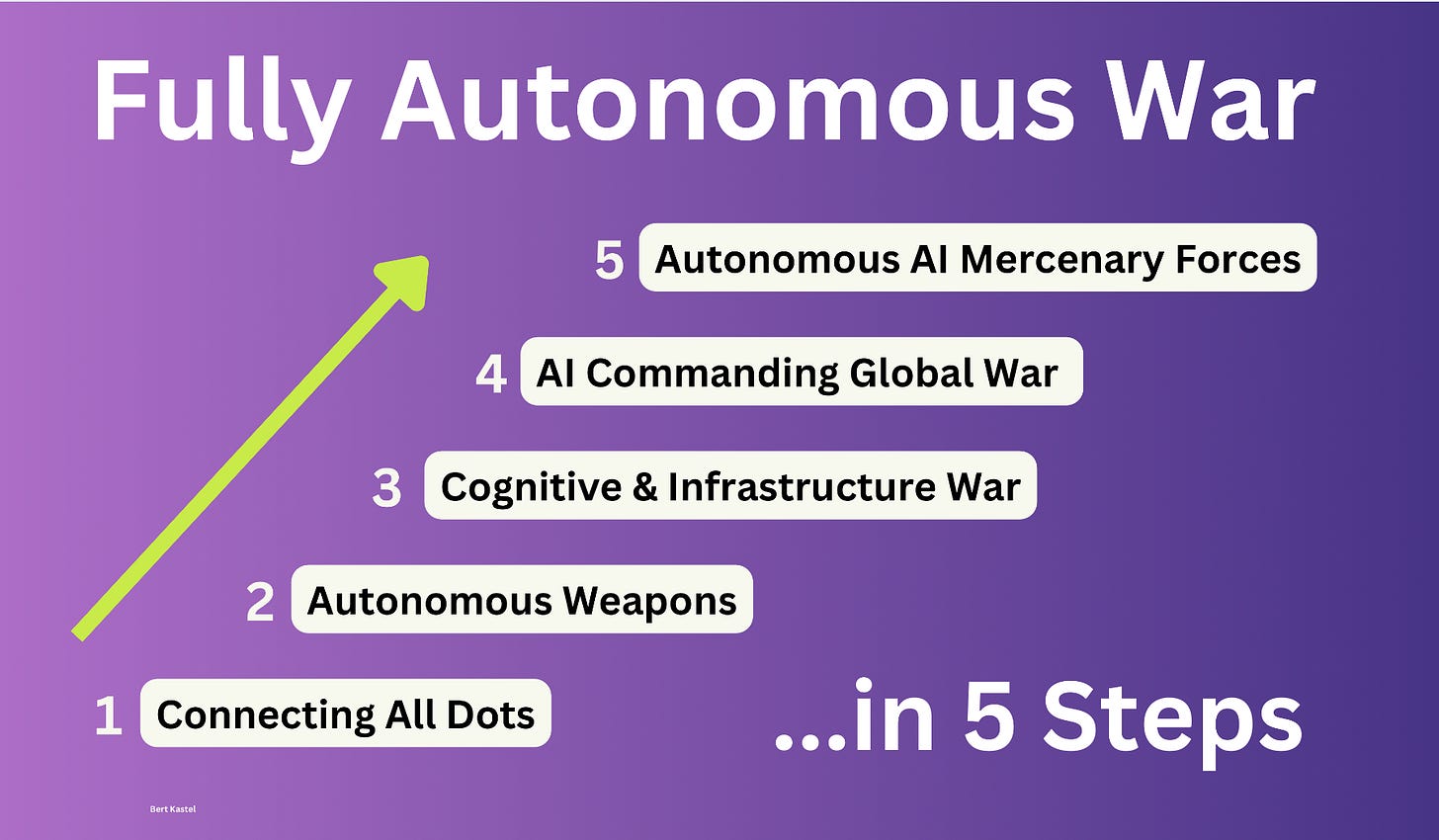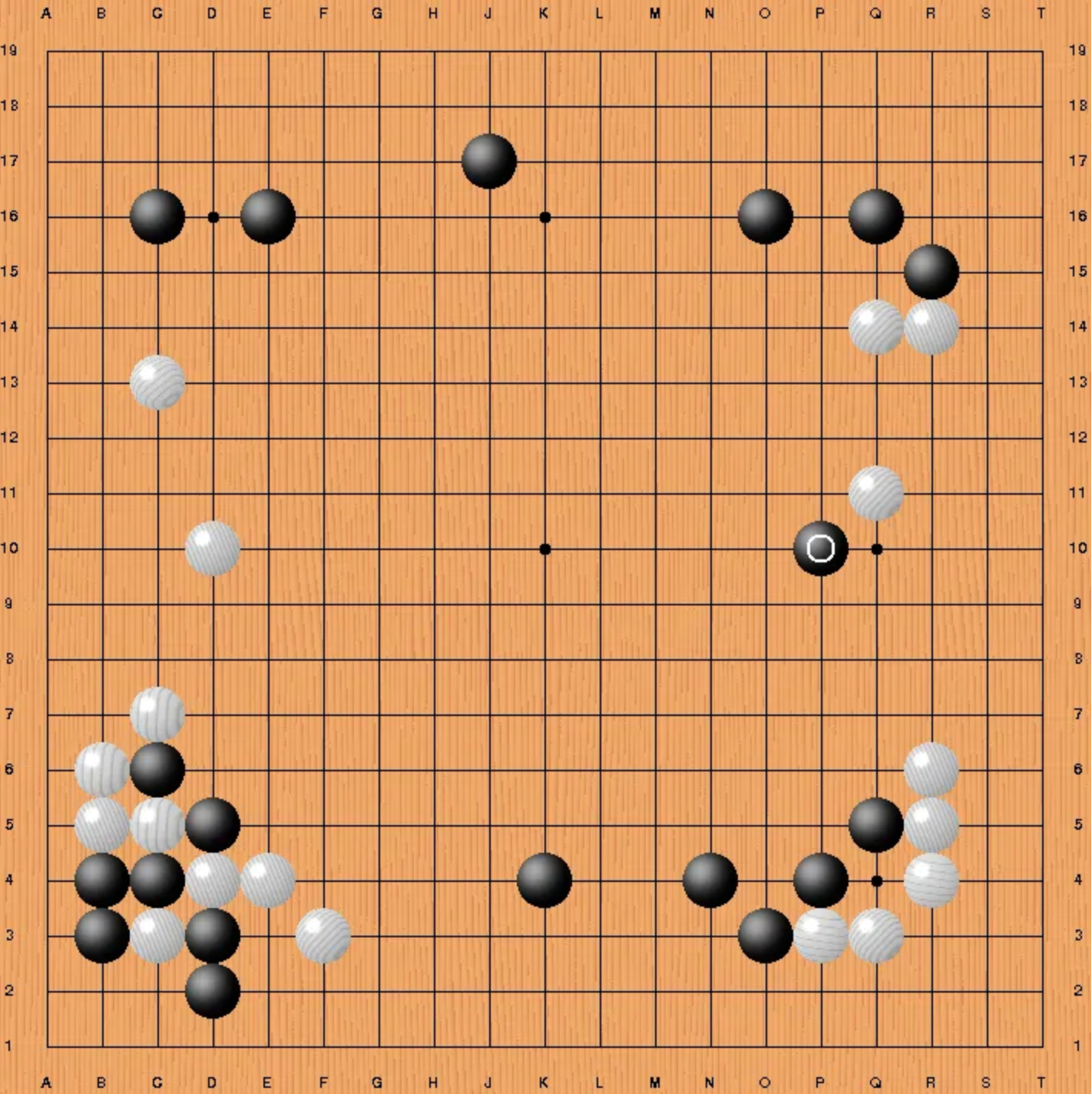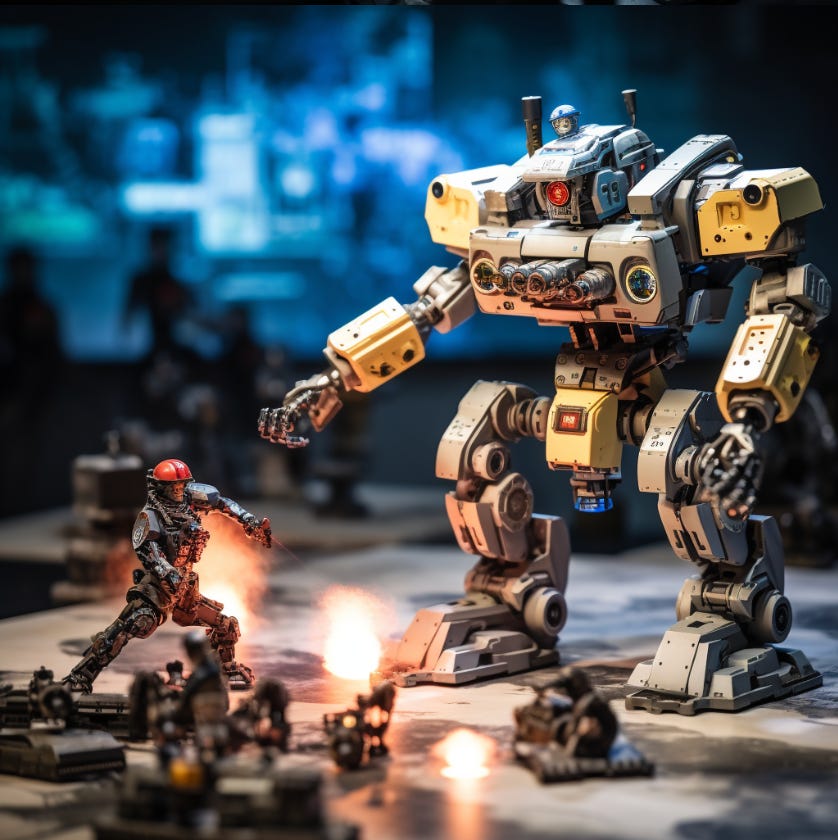Could the U.S. Senate be wrong? Or just not get the full picture?
Because, artificial intelligence does not only give us better old-style weapons, improved situational awareness, or more efficient military logistics. That, though, seemed the conclusion of a public hearing of the U.S. Senate’s Subcommittee on Cyber, Information Technologies, and Innovation on July 18, 2023.
It was consistent with the traditional image most people have of war, of militaries blowing each other and logistical targets up in a geographically confined battlefield. Think Ukraine or Ethiopia, with smart bombs and remote controlled drones.
The reality, though, is much more transformative: Fully-Autonomous War.
“War” is bad. “Autonomous” both promising and scary. But it is the “fully” that directly challenges what makes us HUMANS free and sovereign.
Step 1: Connecting All Dots - Finding Targets
It starts on the tactical level, and in the background.
As the ultimate pattern recognition technology, AI excels at analyzing sensory feeds from drones, satellites, or other sources. Just the quantity and details alone of the input they generate surpasses human abilities to process.
AI can do that job - and much faster and more reliably at that. You need to identify a car bomb? Some piece of artillery? An anti-aircraft gun? An enemy ship, tank, drone or platoon on the move? Done in a second.
But we can take all this far beyond the typical physical confines of a battlefield. AI can efficiently sift through massive data from a variety of what seem only indirectly related sources. This merges sensory input and purely digital data, anything from moving money, phone or online communication, physical movements of objects or people, or even just the weather.
AI is superior at this. No longer does it take human eyes looking at granular details on images. Computer vision does a better job. And the larger scope raises this beyond the tactical. It makes it more comprehensive, effective, and - more strategic
Step 2: Autonomous Weapons - Drones & Swarms
AI also enhances or replaces traditional human operated weapons. These range from robotic drones to ships and fighter planes, with evolving and emerging features.
Autonomy make many traditional weapons cheaper and more capable. We do not need to spend money on feeding, nurturing, and protecting human operators, pilots, or sailors. Extreme g-forces do not push blood into heads of bits and bytes. AIs can react faster, execute more erratic maneuvers, while simplifying logistical supply chains.
The financial impact alone can be significant. An F-35 costs over 70 million dollars. For the same money, you can buy thousands (if not tens of thousands) of high-quality commercial drones who can deliver payloads in novel ways. This is for ONE plane - and the F-35 program comprises thousands of aircraft and an overall budget exceeding $1 TRILLION.
This goes beyond enhancing or replacing weapons we had in the past. Autonomous and self-coordinating flying, swimming, or diving drone swarms add new capabilities. They can operate in flexible but tightly orchestrated manners, overwhelm defenses, provide amorphous depth when attacked. Like schools of fish or swarms of birds, their offensive and defensive capabilities can be enormous.
Not only are they able to maneuver using more extreme moves and with faster responses. They also can come up with surprising and even “inhuman” tactical maneuvers. “Move 37” set up Go world champion Lee Sedol’s loss in his game against AlphaGo. The AI had independently discovered it... and the same will happen on the battlefield.
Step 3: Cognitive Weapons - Hitting Infrastructure & Minds
This then results in new capabilities of AI guided or operated weapons. Some of these are very specific, like optimized execution of more difficult kill shots during dogfights. Others may be new, like tiny autonomous drones aiding in close-quarter combat - or self-directed autonomously operating swarms targeting logistical and even civilian infrastructure, like pipelines, high-voltage lines, fiberoptic cables, or satellites.
The latter then extends the battlefield and theater geographically. Solar-powered autonomously navigating drones can overcome defenses to execute long-range strikes deep in an adversary’s homeland. They may not even be needed, though. A few thousand, or even just several hundred, slightly modified off-the-shelf drones could at least in theory blow up enough electrical substations, or cut power lines, fiberoptic cables, and pipelines, to bring a modern society the size of the U.S. to its knees in a matter of days.
In his just published book “The Coming Wave”, Mustafa Suleyman explained how such a tactic was key to thwart the 2022 Russian attack on Kiev.
And AI can expand the battlefield in even more significant ways. Whether physically by depositing molecules or biological agents via drones, or through purely digital forms of manipulation, it can deliver a range of biological and neuro-technological weapons, and maximize their impact.
The neuro-tech part of this introduces a level of strategic warfare not possible to a similar extent before, ever. It introduces neuro-cognitive warfare as outlined by James Giordano, professor of neurology and biochemistry at Georgetown University.
Application areas range from personalized, manipulative (mis-) information to the potential deployment of novel biological agents in such strategic locations that maximize their impact on populations. They target our brains and people’s neuro-cognitive capabilities.
Such actions can influence individuals, or masses. AI can read what makes each person tick, and also how to influence ‘herds’ of humans. With or without molecules to directly affect neurological pathways, extremely subtle but efficient ways of AI optimized manipulation become omnipotent tools to bring the battlefield into the brains of military personnel and civilians alike.
And thus, the war theater shifts and widens to reach nearly every geographical area and all aspects of our existence. It includes our homelands, moves deep into the digital realm and, by combining the physical and the digital, directly tackles the cognitive aspects of human life.
Step 4: Masters of Strategy - Commanding Global War
So far we mostly stuck to tactical tools leveraging artificial intelligence. But the arguably biggest advantage of AI may be on a strategic level. Like winning in Chess or Go, winning against humans on the battlefield may be easy for a well-trained AI.
To win, “all” we would need to do is delegate strategic decision-making and control and command (C&C) functions to more efficient and capable AI agents.
Of course, this is the exact antithesis of how militaries typically operate. We want a human in the loop, particularly on the top. Anything else is an obvious, and dramatic, ethical challenge, creating a “Terminator Skynet” situation. Could any move be more risky?
But what if not putting AI in charge means losing to the other side doing exactly that?
Because it involves military and civilian leaders, with all their egos and commanding personalities, this is likely the most difficult and slowest piece to implement. For better or worse.
But the question will arise because the speed of decision-making would literally be super-human. And the “quality” of these decisions as well. The definition of war-fighting objectives, and control over them, then would become the most important human contribution.
It would require being very specific about strategic goals. What are we “optimizing” for? Do we “merely” want to sink China’s fleet (or America’s), or prevent any power to dominate the Eurasian landmass, or control Taiwan? It’s an “interesting” variation of AI’s paperclip problem… with many potential horrifying consequences.
Step 5: Fully Autonomous AI Mercenaries - ‘Wagner AI’
And we can still go one step further, combining some of the above elements.
Imagine a self-sufficient mercenary force allowed to autonomously operate, controlled by an AI. Similar to Yevgeny Prigozhin and his Wagner mercenary force.
But different. It would be under the command of an AI that is optimizing its effectiveness. And one that uses not primarily human fighters, although it may. More likely, at last most of its tools would be a range of autonomous, robotic weapons.
Satellites, autonomous planes, flying and swimming drones, tapping into an IoT-based real-time updated digital twin of our planet. All orchestrated in a highly synchronized manner to maximize their impact on the battlefield. Deploying the whole range of AI-powered weaponry described in points 1 through 4, for maximum effect. Some may be stationed in space, without complicated logistical supply chains or limitations by geographical borders.
This force could relentlessly optimize and pursue previously unimagined strategies. It could react at lightning speed to any and all changes on “Battlefield Earth”. Using training that ran billions of scenarios using advanced machine learning algorithms.
Super-human. Non-human.
Also inhumane? But compared to what? Carpet-bombing, minefields, and trench warfare?
Moving beyond the mid-20th Century
None of the above is completely new to researchers at advanced military innovation units like the DIU or DARPA.
But - what we are going to do with this knowledge?
The general public, even many politicians and decision makers, are still stuck in the past. The war in Ukraine seems to confirm that they are correct. And so, most of today’s processes, strategies, tactical operations, and weaponry would still be familiar to mid-20th century warfighters.
Considering the exponential change of digital warfare capabilities, though, this is a damning statement. As long as AI continues to increase its capabilities by a factor of 10 each year (1 billion a decade), looking at the past or even the present is a monumental mistake.




